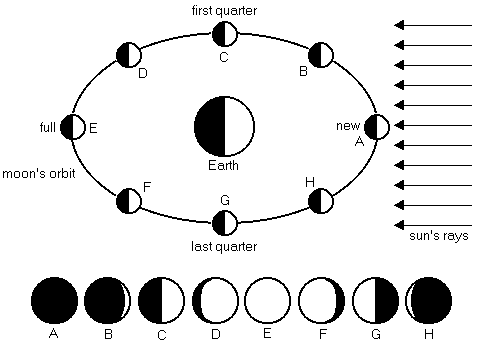
- Has a nearly circular orbit around the Earth
- Distance of 384 000 km from Earth
- One rotation takes 27 1/3 days
- One revolution around the Earth takes 27 1/3 days
- Reflects light from the Sun
- No atmosphere so all UV rays from the Sun reach the surface
- Gravity is only 1/6 of the Earth's gravity
- Craters are deep depressions on the surface caused by meteorites
- Maria (or 'seas') are large smooth areas on the surface covered by plains of grey basalt - like rock
- Lunar highlands and rilles ( long steep-sided valleys) cover the rest of the surface
THE PHASES OF THE MOON
- Revolution of the Moon around Earth - 27.3 days
- Rotation of the Moon on its Axis - 27.3 days
- 'Moonlight' - The Moon does not make its own light. It reflects light from the Sun. Half the Moon is always in sunlight, just as half the Earth has 'day' and the other half has 'night'. From Earth, we can only see 50% of the Moon at any time.
- 8 Moon Phases each Lunar Month of 27.3 days
- New Moon - The face of the Moon facing Earth is completely in shadow ('No Moon'). The Sun, the Moon and the Earth are in line.
- Waxing Crescent - A horn-shaped part of the Moon is illuminated.
- First Quarter - Only half of the face of the Moon facing Earth is illuminated.
- Waxing Gibbous - More than half of the face we see is illuminated.
- Full Moon - All of the face we see is illuminated. The Sun, the Earth and the Moon are in a line.
- Waning Gibbous - More than half of the face we see appears lit.
- Last Quarter - Only half of the face we see appears lit.
- Waning Crescent - A horn-shaped part of the Moon facing Earth is illuminated.
